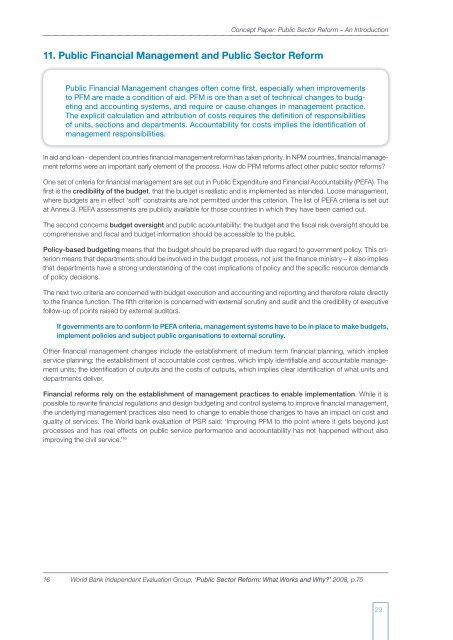Public Sector Reform - Norman Flynn's
Public Sector Reform - Norman Flynn's
Public Sector Reform - Norman Flynn's
Create successful ePaper yourself
Turn your PDF publications into a flip-book with our unique Google optimized e-Paper software.
Concept Paper: <strong>Public</strong> <strong>Sector</strong> <strong>Reform</strong> – An Introduction11. <strong>Public</strong> Financial Management and <strong>Public</strong> <strong>Sector</strong> <strong>Reform</strong><strong>Public</strong> Financial Management changes often come first, especially when improvementsto PFM are made a condition of aid. PFM is ore than a set of technical changes to budgetingand accounting systems, and require or cause changes in management practice.The explicit calculation and attribution of costs requires the definition of responsibilitiesof units, sections and departments. Accountability for costs implies the identification ofmanagement responsibilities.In aid and loan - dependent countries financial management reform has taken priority. In NPM countries, financial managementreforms were an important early element of the process. How do PFM reforms affect other public sector reforms?One set of criteria for financial management are set out in <strong>Public</strong> Expenditure and Financial Accountability (PEFA). Thefirst is the credibility of the budget, that the budget is realistic and is implemented as intended. Loose management,where budgets are in effect ‘soft’ constraints are not permitted under this criterion. The list of PEFA criteria is set outat Annex 3. PEFA assessments are publicly available for those countries in which they have been carried out.The second concerns budget oversight and public accountability: the budget and the fiscal risk oversight should becomprehensive and fiscal and budget information should be accessible to the public.Policy-based budgeting means that the budget should be prepared with due regard to government policy. This criterionmeans that departments should be involved in the budget process, not just the finance ministry – it also impliesthat departments have a strong understanding of the cost implications of policy and the specific resource demandsof policy decisions.The next two criteria are concerned with budget execution and accounting and reporting and therefore relate directlyto the finance function. The fifth criterion is concerned with external scrutiny and audit and the credibility of executivefollow-up of points raised by external auditors.If governments are to conform to PEFA criteria, management systems have to be in place to make budgets,implement policies and subject public organisations to external scrutiny.Other financial management changes include the establishment of medium term financial planning, which impliesservice planning; the establishment of accountable cost centres, which imply identifiable and accountable managementunits; the identification of outputs and the costs of outputs, which implies clear identification of what units anddepartments deliver.Financial reforms rely on the establishment of management practices to enable implementation. While it ispossible to rewrite financial regulations and design budgeting and control systems to improve financial management,the underlying management practices also need to change to enable those changes to have an impact on cost andquality of services. The World bank evaluation of PSR said: ‘Improving PFM to the point where it gets beyond justprocesses and has real effects on public service performance and accountability has not happened without alsoimproving the civil service.’ 1616 World Bank Independent Evaluation Group, ‘<strong>Public</strong> <strong>Sector</strong> <strong>Reform</strong>: What Works and Why?’ 2008, p.7529


